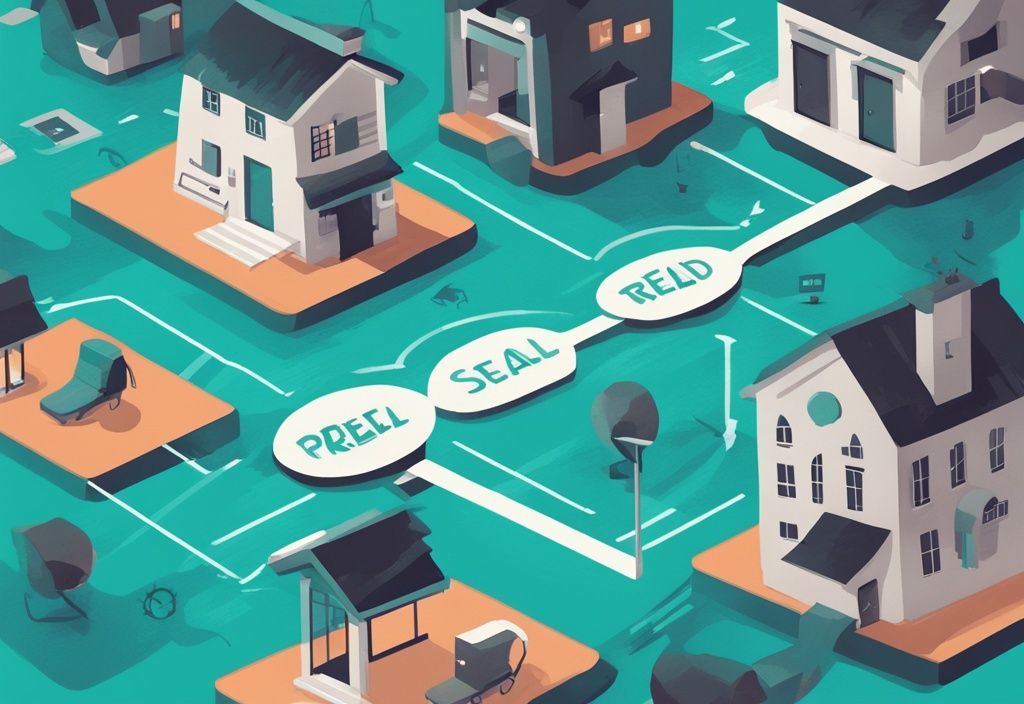Ever wondered what the term ‘disposition’ means in real estate lingo? Well, you’re in luck! As a seasoned real estate expert, I’ll break it down in a way that’d make even a total newbie feel like a pro.
From freeing up cash to funding new investments, the key is understanding how to effectively sell, transfer or liquidate property. And that’s exactly what ‘disposition’ is all about. We’ll uncover its ins and outs and why it’s a gamechanger in property management.
So buckle up, future real estate moguls! It’s time to crack the code on ‘disposition in real estate’. Let’s demystify this term and supercharge your investment strategies!
A Simple Definition of Disposition in Real Estate
Disposition in real estate is all about the process of selling, transferring, or even liquidating properties from your portfolio. Imagine that you could also donate properties, pass them on to heirs, or transfer them to a third party. The main goal here is to give up ownership to boost cash flow or support new ventures.
Now, why would you want to consider disposition? Through this process, you can regain your investment capital, pay off any debts tied to the property, and maybe even make a profit from the sale. Properly managing disposition lets you strategically adjust your portfolio, helping you achieve your broader financial goals.
The Importance of Understanding Disposition in Real Estate
Understanding the ins and outs of real estate disposition is crucial for making informed decisions about when and how to let go of properties, especially when considering various housing statistics available at the National Association of Realtors, which can provide valuable insights into market trends and conditions. Getting a handle on disposition strategies can lead to faster closings, higher returns, and better fund management.
Think of effective disposition as a cornerstone for solid portfolio management. It plays a huge role in your overall financial health and investment performance. Knowing the ropes of disposition means you can fine-tune your property holdings to seize market opportunities and maintain financial stability across your real estate investments.
The Key Steps in the Disposition Process
Understanding what is disposition in real estate is crucial for smoothly navigating the selling phase of any property. This process involves several essential steps, from niche selection to marketing, that ensure you maximize your returns and minimize potential roadblocks. Let’s dive into the key components.
Niche Selection: Where to Start
Picking the right niche is foundational when it comes to mastering what is disposition in real estate. Think of it like choosing a specialization in any field—each property type, whether residential, commercial, industrial, or retail, comes with its own set of dynamics and potential returns. Analyze the current market trends and look for opportunities within your chosen segment to get a sense of where demand is high and how you can best leverage your expertise. Reflect on how these property types align with your investment goals, whether you’re into quick flips or long-term holdings.
Conducting a Financial Analysis
A comprehensive financial analysis is essential for grasping what is disposition in real estate. You’ll need to evaluate the potential return on investment (ROI) by accounting for all associated costs. Include the purchase price, closing costs, holding costs, and any repairs or improvements. Don’t forget to assess the current market value and the after-repair value (ARV) of the property. This step is pivotal in estimating profitability and ensuring the investment aligns with your financial aspirations.
The Process of Purchasing the Property
The acquisition phase is a make-or-break step in the disposition process. Secure adequate financing and gather all necessary documentation for the purchase. Conduct due diligence meticulously to verify every property detail, ensuring there are no hidden issues that might derail your plans. This includes checking legal standings, zoning laws, and the physical condition of the property. Finally, complete the purchase through a structured process involving negotiation, contracting, and closing. Mastering these aspects streamlines your understanding of what is disposition in real estate.
Marketing and Selling Your Property
Marketing is the key to a successful property sale. Craft a comprehensive marketing plan to attract potential buyers. Use different channels like online listings, local MLS, print advertisements, and social media platforms to broaden your reach. Engage buyers through targeted strategies, build a list of interested parties, and follow up consistently. This approach maximizes exposure, helping you achieve a quicker sale and deepening your understanding of what is disposition in real estate.
Understanding Disposition Strategies in Real Estate
Traditional Selling
Traditional selling is the conventional method of disposition in real estate, where you list a property on the open market to attract potential buyers. This process is typically managed by real estate agents who use their expertise to handle marketing, negotiations, and the closing process.
The benefits of traditional selling include broader market exposure, professional guidance through the transaction, and the potential for competitive bidding, which can drive up the final sale price. However, it’s important to choose an agent with a strong track record and comprehensive market knowledge to ensure the best possible outcome.
The Power of Seller-Leaseback Agreements
Seller-leaseback agreements offer a unique disposition strategy where the owner sells the property but leases it back from the new owner. This arrangement allows sellers to liquidate their asset while continuing to use the property, gaining liquidity without interrupting their operations.
This can be particularly advantageous for businesses seeking to release capital tied up in real estate for other investment opportunities or immediate financial needs. Seller-leaseback agreements provide a win-win situation where sellers retain operational control, and buyers acquire a property with a guaranteed tenant, ensuring a steady income stream.
Leveraging Real Estate for Retirement Income
Leveraging real estate for retirement involves holding properties long-term to secure rental income. This strategy provides retirees with a steady income stream through monthly rental receipts, which can help fund their retirement lifestyle.
Additionally, over time, property values tend to appreciate, offering the benefit of increased equity and potential selling profits in the future. This approach requires strategic property selection and effective property management to minimize vacancies and maintain rental income consistency.

Invest in properties located in high-demand areas and keep up with necessary maintenance and renovations. These steps can significantly contribute to long-term financial health during retirement.
Passing Properties to The Next Generation
Passing properties to the next generation involves careful estate planning to ensure a tax-efficient transfer of real estate assets to heirs. This process aims to minimize tax liabilities and legal complications, providing a smoother transition.
Estate planning tools such as trusts, wills, and gifting strategies can be employed to transfer ownership effectively, optimizing for potential estate taxes and other financial considerations. Proper planning prevents disputes and reduces the administrative burden on heirs.
Understanding what is disposition in real estate is essential for this strategy, as it involves relinquishing ownership in ways that preserve the property’s value and benefits for the next generation.
A Closer Look at the Disposition Process
The disposition process in real estate involves several key steps that ensure a property is sold efficiently and profitably. Each stage, from valuation to marketing and identifying potential buyers, plays a crucial role in achieving success.
The Crucial Role of Property Valuation
Accurate property valuation is fundamental to understanding a property’s market worth and potential resale value, especially when delving into what is disposition in real estate. Professional appraisals are a cornerstone of this process, as they provide an unbiased assessment of a property’s value, grounded in market data and condition assessments.
These appraisals not only help in setting realistic sale prices but also enhance negotiation positions with potential buyers. By understanding a property’s intrinsic value, investors can make informed decisions that align with their financial goals, thereby facilitating a smoother and more profitable disposition process.
Crafting an Effective Marketing Plan
Creating an effective marketing plan is crucial for showcasing a property in its best light to attract potential buyers, an essential aspect when considering what is disposition in real estate. Start by ensuring professional photography and detailed listing descriptions that highlight the property’s unique features.
Then, design a multi-faceted marketing campaign that spans traditional media like newspapers and real estate magazines, as well as digital platforms including real estate websites, social media, and email newsletters. This diversified approach maximizes reach, ensuring the property captures the interest of a broad audience.
Consistent and compelling marketing keeps the property top-of-mind for potential buyers, paving the way for successful disposition.
Identifying Potential Buyers: Who They Are and Where to Find Them
Identifying potential buyers is a pivotal part of the disposition process, integral to understanding what is disposition in real estate. These buyers can range from individual investors looking for residential properties to large institutions interested in commercial or industrial spaces.
Key venues to find these buyers include real estate websites and online directories, such as Zillow or Realtor.com, where listings receive significant visibility. Additionally, investor networks and real estate investment groups are valuable resources for connecting with interested parties.
Local advertisements, such as those in community bulletins or regional magazines, also provide targeted outreach within your property’s vicinity. By tapping into these varied venues, sellers can effectively reach their ideal buyer audience.
Market Variables: How They Affect Disposition
Market conditions can swing the timing and profitability of selling your real estate. Dive into why economic trends are so impactful and how to use them to your advantage.
Understanding the Influence of Market Conditions
Imagine you’re deciding when to sell a valued property. Market conditions, like interest rates and supply and demand, are the North Stars guiding these decisions. When interest rates are low, buyers tend to swarm, boosting your property’s appeal. On the other hand, high rates can scare off potential buyers, stretching out the time it takes to sell.
To maximize returns, keep a close eye on housing market cycles and economic forecasts. If you strategically plan, you can hit the market when buyer demand is at its peak, turning the alignment of these variables into a profitable sale.
How Property Condition Plays Into Disposition
Think of your property like a contestant in a beauty pageant. The better it looks, the more attention it garners. A well-maintained property can significantly speed up the sale process and even bring in higher offers. Buyers are usually inclined to invest in homes needing fewer repairs. So, giving your property a facelift—whether it’s a fresh coat of paint or a full renovation—can make a world of difference. A spruced-up home doesn’t just look good; it screams “Ready and Waiting!” to serious buyers, which can positively impact the final sale price.
The Impact of Your Marketing Plan’s Quality
Your marketing plan is the megaphone for your property in a bustling marketplace. Effective marketing can elevate your property from obscurity to being in the spotlight. This means using professional photos, compelling descriptions, and a clever strategy that leverages everything from online listings and social media to good old-fashioned print ads.
A well-crafted marketing plan isn’t just about reaching more people; it’s about reaching the right people. The goal is to attract serious, interested buyers who are more likely to close the deal, and do it quickly, often resulting in better offers. This strategic exposure can make all the difference in how swiftly and profitably you can finalize your property’s disposition.
In summary, mastering the timing, condition, and marketing of your property are the secret ingredients for a successful disposition. Balancing these factors can help turn a daunting real estate process into a successful venture, ensuring you get the best possible outcome on your sale.
Creative Disposition Strategies You Can Apply
Thinking outside the box can yield remarkable results in real estate. Here, we’ll explore some creative disposition strategies that can help you maximize your property’s value and expedite the sales process.
The “Fix and Flip” Method Explained
The “Fix and Flip” strategy is one of the most popular creative disposition strategies in real estate. Imagine you find a property that’s seen better days—maybe it’s a bit run-down or just in need of some modern touches. By purchasing this distressed property, rolling up your sleeves, and giving it a makeover, you can transform it into a buyer’s dream home. The trick is in the details: efficient renovations, smart updates, and keeping an eye on the bottom line. Quick turnarounds are key—you want to minimize holding costs but still deliver a quality home. This doesn’t just boost market value; it also attracts buyers ready to pay a premium for a place that’s move-in ready. It’s all about seeing the potential in the overlooked and taking action to realize it.
An Intro to Seller Financing and Installment Contracts
Seller financing is another gem in the realm of creative disposition strategies. Picture this: instead of waiting for a buyer to secure a traditional mortgage, you directly offer them the financing. What does this mean? Flexible payment terms tailored to their needs, opening doors for those who might not fit the conventional lender’s mold. You, as the seller, become the lender, turning a sale into a steady stream of income through interest payments. It’s a win-win: buyers bypass the often cumbersome loan approval process, and you facilitate quicker, smoother sales, especially in slower markets.
Understanding Original Seller’s Financing Terms
Leveraging the original seller’s financing terms can also make a property more enticing. Think of options like assuming the seller’s existing mortgage. The buyer takes over the remaining balance and terms, often securing better interest rates than those available with new financing. This strategy includes creative solutions like wraparound mortgages or subject-to deals, where the existing loan stays put, and the buyer makes payments to the seller. It’s a simplified transaction, widening the pool of potential buyers by offering approachable and flexible financing. In essence, you’re providing a lifeline to buyers while maintaining a streamlined sale process.
The Essential Players in Disposition
When delving into what is disposition in real estate, it’s crucial to understand the key players who make this process smoother and more profitable. In this section, we’ll explore the invaluable roles of both commercial brokers and legal teams, shedding light on why their expertise is indispensable.
Why You Need a Commercial Broker
In the intricate world of what is disposition in real estate, having a commercial broker by your side can make all the difference. Picture them as the GPS for your real estate journey, guiding you through every twist and turn with expertise and market savvy. These professionals bring unparalleled knowledge, helping you understand market trends, pinpoint potential buyers, and set realistic sale prices.
Commercial brokers are your transaction maestros, adept at managing every complex detail. They’re like the conductors of an orchestra, ensuring that each aspect of the disposition process is harmonious and efficient. Their negotiation skills? Absolutely invaluable. They work tirelessly to secure the best terms and prices for your property. And when it comes to marketing, brokers have got you covered. From crafting professional listings to leveraging various channels, they ensure your property catches the eye of qualified buyers. It’s a comprehensive approach that not only simplifies the process but maximizes your returns.
The Crucial Role of a Legal Team
Navigating the legal landscape of what is disposition in real estate can feel like decoding a foreign language. That’s where a competent legal team comes in. Think of them as your translators, ensuring that every legal aspect of the disposition is meticulously managed and compliant. Their responsibilities range from drafting and reviewing contracts to handling title transfers and meeting regulatory requirements.
Legal experts are the unsung heroes, guiding you through real estate laws and minimizing the risk of disputes and liabilities. They help structure deals that are both legally sound and financially smart, addressing potential issues before they arise. This proactive approach ensures a smooth transaction from the initial agreement to the final closing. With a legal team on board, you can embark on your disposition journey with peace of mind, knowing every detail is covered.

In addition to these core responsibilities, legal teams can assist with estate planning, navigate tax implications, and handle any other legal intricacies that come up. Their comprehensive oversight means your investment is well protected, aligning perfectly with your long-term financial goals.
The Tax and Regulatory Aspects of Disposition
Understanding the tax and regulatory aspects of disposition in real estate is crucial. Here’s a closer look at what influences these decisions and how you can navigate them successfully.
How Market Conditions Can Impact Disposition Decisions
Market conditions significantly affect what is disposition in real estate, impacting both the timing and feasibility of property sales. You see, fluctuations in interest rates, supply and demand, along with the overall economic health, determine the best times to sell. For instance, in a seller’s market, high demand and low inventory might allow you to sell quicker and at higher prices, boosting your after-tax profits. Conversely, in a buyer’s market, it might be smarter to hold onto your property until the conditions improve. Real estate investors, aiming for the highest returns, must regularly analyze these trends to ensure optimal financial outcomes from their investments.
Noteworthy Regulatory Considerations
Regulatory considerations are pivotal in understanding what is disposition in real estate. Navigating the maze of local, state, and federal laws is essential for smooth transactions, and it protects you from fines or legal hassles. Different property types come with their unique regulations. Imagine commercial properties; they often face stricter zoning laws than residential ones. Ensuring compliance requires thorough due diligence, covering environmental regulations, building codes, and tenant rights. Engaging a legal team with expertise in real estate law can help manage these complexities, ensuring your property dispositions are both smooth and compliant.
Key Tax Rules to Bear in Mind
Understanding key tax rules is fundamental in mastering what is disposition in real estate. Capital gains tax is at the forefront here. Knowing when and how gains from property sales are taxable can significantly shape your disposition strategies. For example, exemptions like the primary residence exclusion can offset taxable gains for qualifying properties. Additionally, tax-deferred strategies, such as 1031 exchanges, allow you to defer capital gains taxes by reinvesting proceeds into like-kind properties. These strategies not only enhance your liquidity but also support long-term wealth growth by enabling continuous reinvestment without immediate tax liabilities. Consulting with a tax professional ensures you optimize these benefits, making savvy and legally sound financial decisions.
Why Mastery of the Disposition Process is Beneficial
Mastering the disposition process in real estate can yield significant benefits, from faster deal closures to higher returns on investment. Below are insights on how to streamline this process effectively.
How to Close Deals Faster
Efficiently managing each step of the disposition process in real estate involves strategic planning and the involvement of experts. By utilizing professionals such as legal teams and commercial brokers, all necessary actions can be performed swiftly and accurately.
Effective time management tools and streamlined operations help minimize delays, ultimately reducing the time a property remains on the market. This swift execution translates to decreased holding costs like taxes, insurance, and maintenance, thereby enhancing overall profitability.
Where To Create Demand and Find Buyers
Creating demand for property disposition in real estate requires leveraging various marketing strategies. A targeted marketing plan incorporates diverse channels such as online listings, local MLS, social media platforms, and print advertisements to reach a broad audience.
By identifying potential buyers through real estate websites, investor networks, and local advertisements, effective outreach can be initiated and consistent follow-up maintained. Crafting compelling promotional content and utilizing professional photography can significantly boost buyer interest and foster strong demand for the property.
Gaining Higher Returns From Your Investment
Achieving higher returns through strategically managed disposition efforts hinges on multiple factors. Implementing efficient disposition processes, such as accurate property valuation, effective marketing, and skilled negotiation, results in higher sale prices and faster transaction closes.
Reducing holding costs and maximizing profitability through well-informed decisions and expert involvement are key components. Utilizing the best practices in property disposition ensures that each phase from niche selection to final sale is optimized, maximizing the return on real estate investments.
Tools and Strategies for Better Disposition Management
When it comes to navigating the complexities of real estate disposition, having effective tools and strategies at your disposal can make all the difference. From leveraging digital communities to utilizing cutting-edge data analytics, these methods can help you streamline your processes and maximize your returns.
Virtual Networking and How It Can Help
Virtual networking has truly revolutionized the way real estate investors connect and collaborate. By diving into online real estate communities and networks, you can effectively reach out to potential buyers and key industry players. Think of it like joining a vibrant club where professionals share insights, build relationships, and collaborate on deals.
Such platforms furnish an excellent opportunity to expand your contact base and market reach. You’ll also stay updated with the latest industry trends and developments. Engaging in thought-provoking discussions, attending informative webinars, and following industry leaders can keep you well-informed about current market conditions, emerging opportunities, and innovative disposition strategies. This continuous learning and networking will significantly enhance your decision-making and strategic planning, making your journey in what is disposition in real estate more rewarding.
Why Use Real Estate Data Providers
In today’s data-driven world, using real estate data providers is indispensable for making informed decisions about property disposition. Imagine having advanced data analytics at your fingertips, delivering deep insights into market trends, buyer behaviors, and investment opportunities.
Real-time market data equips you to identify the best times to sell properties and formulate optimal pricing strategies to maximize returns. Access to detailed property histories, comparable sales data, and predictive analytics empowers you to approach disposition with confidence and precision.
By leveraging these sophisticated tools, you can streamline your disposition process, minimize risks, and achieve better financial outcomes. These resources are not just tools—they’re your compass in navigating the complex terrain of what is disposition in real estate.
The Role of Disposition in Estate Planning
Whether you are managing a portfolio or planning your family’s estate, understanding the role of disposition in real estate is fundamental to achieving financial and personal goals. Here’s how effective property disposition can streamline estate planning and enhance asset value.
Effectively Handling Properties in Estate Planning
Strategically managing the disposition of properties is crucial in estate planning to streamline the settlement process and meet financial objectives. Properly handling the disposition can help alleviate potential conflicts among heirs and reduce the complexity of asset distribution. By deciding in advance whether to sell, manage, or transfer properties, investors can safeguard the estate’s value and ensure a smoother transition of assets.
Optimizing estate value often involves a comprehensive assessment of each property’s worth, potential tax implications, and the desires of the heirs. Considering market conditions and the specific financial needs of the estate, investors might choose to liquidate certain assets to provide immediate liquidity, which can be instrumental in covering estate taxes and other liabilities. Conversely, retaining properties might offer prolonged financial benefits through rental income and appreciation, supporting long-term wealth preservation.
The Pros and Cons of Direct Inheritance by Heirs
Direct inheritance of property can pose significant tax implications and liquidity challenges for heirs. When properties are passed on directly, heirs might face hefty estate taxes, capital gains taxes, or property taxes, potentially diminishing the estate’s overall value. Additionally, the complexity of co-ownership or the responsibility of managing inherited properties can become burdensome, especially if heirs are unprepared or uninterested in real estate management.
On the advantageous side, direct inheritance allows for the potential growth of wealth through property appreciation and rental income. Proper planning can mitigate some of the drawbacks, for example, by setting up trusts or implementing a phased transfer of property ownership under favorable terms. These strategies can help balance the liquidity needs of the heirs with the desire to preserve valuable real estate assets within the family, ensuring that the benefits of the inheritance are maximized and any associated drawbacks are minimized.
By addressing these factors, estate planners can provide clarity and security to heirs, ensuring the estate’s intentions are honored and financial stability is maintained across generations.
Understanding Timelines in the Disposition Process
When it comes to real estate, understanding the disposition process is key, particularly how timeliness affects everything from final sale prices to overall profitability. The following sections will delve into smart strategies for managing time efficiently and minimizing costs during disposition.
Time Management for Faster Sales
Efficient time management is crucial in the disposition process to ensure minimal delays and optimal outcomes. One essential aspect is breaking down the entire process into manageable phases, such as pre-listing preparations, active marketing, buyer negotiations, and closing. By segmenting each phase, you can address potential bottlenecks early on and keep things moving smoothly.
Using project management tools can significantly enhance this process. Platforms like Trello, Asana, or Microsoft Project allow for seamless scheduling and tracking of tasks. Establishing clear deadlines and responsibilities ensures all team members are aligned and progress is promptly monitored.

Additionally, consistent communication and regular status updates keep everyone informed and ready to address any issues swiftly, ultimately speeding up the sale timeline. Imagine organizing a family road trip: breaking it into stages—planning, packing, driving—makes the journey smoother and more enjoyable for everyone involved.
How to Minimize Holding Costs
Minimizing holding costs is a critical consideration in real estate disposition. These costs, including taxes, insurance, and maintenance, accumulate over time and can significantly impact profitability. The key to reducing these expenses lies in shortening the time a property remains on the market.
Implementing pre-listing preparations is an effective strategy. Before marketing the property, ensure it is in top condition by conducting necessary repairs and enhancements. This not only makes the property more appealing to buyers but can also lead to quicker offers.
Moreover, an aggressive marketing strategy can expedite the sale process. Leveraging multiple marketing channels—from online listings to social media platforms and local advertisements—can increase visibility and attract more potential buyers in a shorter period.
Incorporating these strategies diligently can result in a swift disposition process, reducing holding costs and maximizing returns on investment. Think of it like tidying up before guests arrive; the better prepared you are, the quicker the party gets started, and the more everyone enjoys themselves.
Conclusion
Understanding what is disposition in real estate is crucial for both novice and seasoned investors. Mastering the disposition process not only enhances your ability to manage and liquidate properties effectively but also serves as a pivotal strategy to optimize financial returns and investment portfolios.
To recap, we began by defining disposition in real estate as the process of selling, transferring, or liquidating properties from an investment portfolio. This practice is essential for investors to recoup their initial capital, pay off existing debts, and possibly realize profits. Understanding the fundamentals of disposition can lead to well-informed decisions regarding when and how to divest properties to maximize returns.
Next, we delved into the importance of understanding the disposition process. Recognizing its intricacies can significantly contribute to more informed investment decisions, faster closes, higher returns, and superior fund management.
The key steps in the disposition process were outlined, starting with niche selection, conducting financial analyses, purchasing property, and finally, marketing and selling. Each of these steps plays a critical role in ensuring a seamless and profitable disposition.
Different disposition strategies were explored, including traditional selling and more creative methods like seller-leaseback agreements and passing properties to the next generation. These strategies provide various avenues to achieve the ultimate goal of effective property liquidation.
The section on market variables emphasized the importance of market conditions, property condition, and the quality of your marketing plan. Each of these factors influences the success rate of property disposition.
Creative disposition strategies such as the “fix and flip” method and seller financing were discussed. These methods illustrate how innovative approaches can facilitate successful dispositions even in a competitive market.
Essential players in the disposition process like commercial brokers and legal teams were highlighted, underlining their roles in navigating complex transactions and ensuring legal compliance.
Finally, we touched upon the tax and regulatory aspects of disposition, stressing the importance of understanding market conditions and regulatory frameworks. This knowledge helps to make strategic decisions that maximize after-tax profits.
In mastering the disposition process, real estate investors can achieve faster sales, higher returns, and effective demand creation, all while minimizing holding costs. Tools such as virtual networking and real estate data providers further facilitate better disposition management, ensuring that investors stay ahead of market trends and make data-driven decisions.
By internalizing these principles of disposition in real estate, investors can enjoy a more streamlined process. This ultimately contributes to their overall financial health and growth in their property investments.
FAQs on Real Estate Disposition
What are the Main Steps in the Real Estate Disposition Process?
Diving into the real estate disposition process can feel a bit like navigating a well-laid-out road map. The journey begins with niche selection, where you pinpoint the market segment you want to target. Next up is conducting a financial analysis to understand the economic implications. Then comes the property purchase, marketing it effectively, identifying potential buyers, engaging in negotiations, and finally, closing the deal. Each step is like a puzzle piece, essential for ensuring a smooth and profitable disposition. Picture this: being aware of your market niche means you know your audience, conducting a financial analysis keeps surprises at bay, and strategic marketing guarantees your property gets the spotlight it deserves.
How Does Market Condition Impact Real Estate Disposition?
Think of market conditions as the weather forecast for your real estate disposition journey. Just like sunny weather can enhance your outdoor plans, favorable market conditions can lead to higher prices and quicker sales. Conversely, stormy market conditions might slow you down, affecting pricing and buyer interest. Keeping a pulse on market trends and economic indicators is like carrying an umbrella – it helps you prepare and make strategic decisions.
How Significant is Property Valuation in Disposition?
Property valuation is the compass guiding your real estate disposal journey. It sets the direction for pricing and negotiations. An accurate property valuation unveils the true market worth, giving you a realistic expectation of the resale value. It’s like knowing the exact worth of a treasure you possess, which empowers you to attract serious buyers and negotiate effectively. Professional appraisals are your trusted treasure maps, providing precise figures to navigate smoothly toward a successful deal closure.
What Creative Strategies Can I Use for Real Estate Disposition?
Creativity in real estate disposition can be a game-changer. Imagine approaching your property sale with fresh strategies like the fix and flip method, seller financing, installment contracts, or leveraging existing seller financing terms. These tactics are like a multi-tool gadget, offering flexibility and attracting a broad range of buyers. Each strategy caters to different market needs and financial capabilities, maximizing your returns and speeding up the selling process. It’s about turning challenges into opportunities and creating win-win scenarios for everyone involved.
Why Do I Need a Professional Team in Real Estate Disposition?
Having a professional team in real estate disposition is like assembling a dream team for a big project. Legal advisors help you navigate the regulatory landscape, ensuring everything is above board. Financial experts manage investment strategies, keeping the numbers in check. Marketing professionals craft and execute campaigns that attract buyers. Together, this team ensures smoother, more profitable transactions. Their collective expertise transforms potential hurdles into stepping stones, guiding you toward a successful disposition.
What Are the Tax Implications of Real Estate Disposition?
Diving into the tax implications of real estate disposition is crucial for understanding the financial landscape you’re navigating. Capital gains tax can impact your net profits significantly, while tax-deferred strategies like 1031 exchanges can offer substantial savings. Regulatory requirements often add another layer of complexity. Imagine it as optimizing your financial outcomes by understanding the rules of the game. Consulting with tax professionals can offer invaluable guidance, ensuring you maneuver through these regulations efficiently and maximize your financial gains.
Hi, I’m Alex Harper, a real estate expert with over ten years of experience in property management and legal advice. My passion is making the often complicated world of real estate understandable. I share practical tips and simple solutions to help you make better decisions – whether you’re buying a home, renting or just want to learn more about the industry. With my knowledge and experience, I want you to feel well-informed and confident in your real estate projects. Let’s tackle this together!




